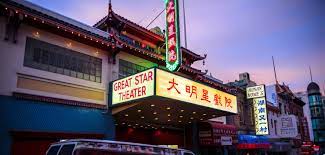Group 7 | Blog Post #2
This week, we consulted secondary sources to understand the film culture and history of Chinatown and the Great Star Theater.
After reading “Chinatown Modernity: Revolutions and Movie Theaters” in Chinatown Film Culture : The Appearance of Cinema in San Francisco’s Chinese Neighborhood, we gained a more comprehensive understanding of movie theaters’ roles in the San Francisco Chinatown. Movie theaters were not simply sites for public entertainment, but important signs of modernization that challenged the traditions embraced by the older generation of Chinese immigrants. Western mentality became more and more popular and dominant when Chinatown was rebuilt after the earthquake. An important part of such mentality was urban modernity embraced by younger generations of Chinese immigrants. In particular, Moviegoing was considered a sign of such modernity. This disheartened and alarmed older generation Chinese immigrants, who were struggling to accept that the untraditional behaviors brought by modernity is becoming part of the contemporary Chinatown identity. Further, they considered these behaviors representations of the uncivilized aspects of Western lifestyle that discriminated and victimized immigrants. The new generation, on the other hand, departed from the traditional lifestyle pursued by older generations and were eager to pursue modernity, for example, by taking a beautiful girl to the movies. In this way, by creating a cultural clash between the old Chinatown and the new Chinatown, movie theaters had polarizing and subversive effects on Chinese immigrants’ sense of community and identity.
Another role of the movie theaters was that they became the venues for political mobilization that reflected the Republican uprising in mainland China. Movie theaters provided people the space for charity events and community gatherings. For example, Young China Association, a progressive political group, organized several fundraisers at Chinatown’s movie theaters to aid those who were starving in Southern China and to gather support for the Young China movement back in China. In this way, the local movie theater not only became a contested space for Chinatown modernity, but also an outlet for progressive political messages.
Further, as we continue our research on the Great Star Theater and its impact on San Francisco’s Chinatown, we became interested in the role the theater played during key historical moments in Chinatown’s history. This means we needed to learn more about the history of San Francisco’s Chinatown.During our research, we found out a lot of information about the history of Chinatown. We learned that San Francisco’s Chinatown is the oldest in North America. It was affected by several historical events that also impacted San Francisco. It grew due to things such as the Gold Rush, which increased the amount of people who immigrated to California. However, they had to deal with a lot of racism, which mounted the Chinese Exclusion Act of 1882. This as well as the Great Earthquake and their subsequent fires in 1906, greatly diminished the immigrant population, which impacted Chinatown as well.
As we do more research, we also start to realize we might hone in on a specific time period of how the theater and Chinatown’s history interact with each other. This means we also wanted to look into events that impacted Chinatown during the time period of 1940’s-1970’s. There are a few historical events within the United States that also impacted these areas. For example, the Immigration and Naturalization Act of 1965, which led to an uptick of immagration, especially from Asian countries. This led to the growth of Chinatown. Despite some struggles with gang violence during this time, Chinatown experienced prosperity.
Questions: Our next steps into the research might include going deeper into the history of the Great Star Theater and how itself changed throughout this time period and see what this place did for the community at large. The Great Star theater was built in 1925, not long after the controversial modernization and political uprising took place in Chinatown. In the following blogposts, we hope to investigate the political moments in Chinatown’s history when the theater became an important site for mobilization and community gathering. We are also curious to know how the performances the theater presented for the public change in relation to its interaction with Chinatown’s changing history.

This post provides a nice overview of some history specific to Chinatown and theaters as a community space. Your group's engagement with this particular source is really helpful in laying the groundwork for further questions. I really like the questions you pose throughout, such as your interest in looking at 1940-1970 history of Chinatown, and finding out more about the Great Star theater. It would be great if you can start looking through primary sources at the library such as EAL and Ethnic Studies Library collections (and maybe newspapers and microfilm will be helpful especially), once you identify specific moments or events that occurred in SF Chinatown and at the Great Star theater. Looking forward to reading the next post!
ReplyDelete